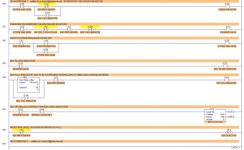jaywillnot
Lifetime Supporting Member
After months of beating my head against the keyboard  trying to figure out why my programs wouldn't work the way I expected them to, I read one post on here (don't remember which post it was) that put everything into clear perspective.
trying to figure out why my programs wouldn't work the way I expected them to, I read one post on here (don't remember which post it was) that put everything into clear perspective.
For the life of me, I couldn't figure out the difference between "virtual" XIO contacts and "hardwired" NC contacts. I then realized after reading the post that the proverbial light went off in my noggin. Basically the PLC has no idea how the field devices are wired, and frankly it doesn't care....all the processor knows is 1 or 0, On or Off
It was driving me crazy why a physical E-Stop button with normally closed contacts would be written as a normally open condition....that was until I sat down with a practice PLC, a (NO) push button, a (NC) stop push button, a relay, and a couple of LEDs. While I was wiring them up in different variations to pass and fail, I realized that even though when we write a conditional rung with a normally closed condition the state of that condition and the state of the field device can be two totally separate entities, operating in two different fashions (ie, if the NC input is in-fact virtual and needs no outside signal to energize or if it is receiving signal from a real world switch, PB...etc)
I can't believe it took me this long to figure out the difference between real world relay logic and processor relay logic. But I guess that's one of life's lessons learned as a maintenance tech learning PLC ladder logic.
"In order to use logic one must put away logical thinking" That's my new quote
Sorry this thread is so long, but I'm kinda ecstatic at the moment!
For the life of me, I couldn't figure out the difference between "virtual" XIO contacts and "hardwired" NC contacts. I then realized after reading the post that the proverbial light went off in my noggin. Basically the PLC has no idea how the field devices are wired, and frankly it doesn't care....all the processor knows is 1 or 0, On or Off
It was driving me crazy why a physical E-Stop button with normally closed contacts would be written as a normally open condition....that was until I sat down with a practice PLC, a (NO) push button, a (NC) stop push button, a relay, and a couple of LEDs. While I was wiring them up in different variations to pass and fail, I realized that even though when we write a conditional rung with a normally closed condition the state of that condition and the state of the field device can be two totally separate entities, operating in two different fashions (ie, if the NC input is in-fact virtual and needs no outside signal to energize or if it is receiving signal from a real world switch, PB...etc)
I can't believe it took me this long to figure out the difference between real world relay logic and processor relay logic. But I guess that's one of life's lessons learned as a maintenance tech learning PLC ladder logic.
"In order to use logic one must put away logical thinking" That's my new quote
Sorry this thread is so long, but I'm kinda ecstatic at the moment!




